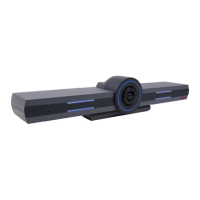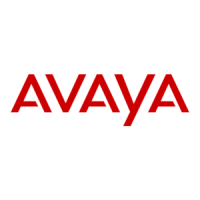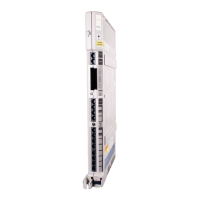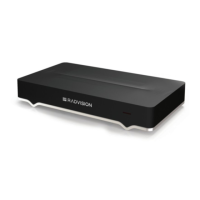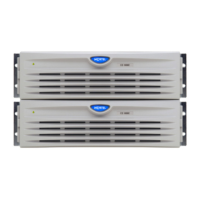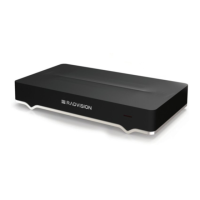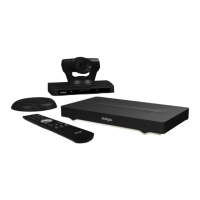Do you have a question about the Avaya IX Collaboration Unit CU360 and is the answer not in the manual?
Explains the document's scope and target audience for installing, administering, and maintaining the Avaya IX™ CU360.
Details the capabilities and functionalities of the Avaya IX™ CU360 endpoint, including video quality and compression methods.
Describes the various ways to interact with the Avaya IX™ CU360, including touch screen and web interface.
Explains the features and usage of the 2.4GHz optical air mouse and keyboard remote control unit.
Details the camera components, pan/tilt mechanism, and status indicators on the Avaya IX™ CU360.
Provides guidance on optimal room configuration for the best Avaya IX™ CU360 experience in huddle rooms.
Explains how to integrate Avaya IX™ CU360 with Microsoft Outlook calendars using Exchange Web Services.
Lists the web browsers compatible with the Avaya IX™ CU360 web interface.
Details the supported video resolutions for various conference types.
Discusses the installation and use of free Android-based third-party applications on the CU360.
Provides support information and limitations for third-party applications used with the CU360.
A step-by-step checklist to guide the initial setup of the Avaya IX™ CU360 hardware and basic configuration.
Details the process of connecting the Avaya IX™ CU360 endpoint, including HDMI and power adapter.
Explains how to power the Avaya IX™ CU360 on, off, or put it into standby mode using the power button.
Instructions on how to pair the remote control unit with the Avaya IX™ CU360 via its LED indicator.
Guide on accessing and logging into the Avaya IX™ CU360 web interface using default credentials.
Overview of methods for configuring basic settings, including Easy to Start, Auto Provisioning, and Manual Setup.
Steps to automatically configure the CU360 for Avaya Equinox Conferencing using a service code.
Guide on manually configuring basic settings of the Avaya IX™ CU360 using the quick setup wizard.
Explains the fields used in the quick setup wizard for initial configuration like system name and protocol type.
How to connect the Avaya AV Grabber kit for sharing computer content in meetings.
Steps to connect the Avaya B109 Conference Phone via Bluetooth to the CU360.
How to set call answering preferences like mute, volume, video privacy, and auto-answer.
How to enable advanced settings for further configuration options on the CU360.
Setting advanced options for call protocols, call types, and call rates (Kbps).
How to configure the CU360 to automatically share computer content during meetings.
Steps to configure meetings to start with video disabled by setting video privacy to Yes.
How to save meeting recordings in MP4 format to USB or enterprise network.
Explains fields related to meeting recording locations, resolution, and bitrate.
How to set the time delay for the screen saver, including options like Never or 30 minutes.
Setting confirmation prompts before disconnecting calls to prevent accidental disconnections.
How to manually configure or modify LAN connection settings for the CU360.
Manually configuring or modifying H.323 gatekeeper connection settings for the CU360.
Steps to connect to a WiFi network and configure settings like security and MTU.
How to enable and configure Bluetooth connections for the Avaya IX™ CU360.
Guide to installing applications from unknown sources after authorizing them in settings.
Steps to associate a room resource with a delegate account for calendar access.
Explains fields for Exchange server connection, address, email, and password.
How to map FQDNs to join meetings directly from the CU360 GUI or web interface.
Defines fields for meeting FQDN, dialing FQDN, prefix, and call protocol for calendar meetings.
Introduces security configurations for the CU360, including PIN protection and call blocking.
How to set up PIN protection for configuration changes to enhance security.
Enhancing security by blocking calls from invalid numbers or IP addresses.
How to prevent users from accessing certain features like Android apps and desktop settings.
Limiting third-party app installations to specific users via PIN, pattern, or password.
How to configure system date, time, time zone, and NTP server settings.
Explains fields for Internet Time, NTP servers, and refresh time settings.
Steps to manually set the time zone and daylight saving time for the CU360.
Details fields for geolocation, time zone selection, and daylight saving adjustments.
How to set system names, Unicode names, and display modes for the CU360.
Explains fields for system name, including initial setup name and Unicode name.
Setting audio coding and video frequency based on country and regional standards.
Details fields for country, language, audio coding, and video frequency settings.
How to configure LDAP directory for storing users' call information and integrating with systems.
Explains LDAP server types, addresses, ports, usernames, passwords, base, and filters.
How to prevent users from editing the local contact directory by locking it.
Enabling automatic display of contacts from external LDAP directories in the CU360.
Steps to hide the list of recent calls from the user interface.
How to hide the call rate selection list from the user interface.
Steps to disable the startup sound notification for the CU360.
How to enable cycling through menu items using arrow keys on the home, camera, and call panels.
How to change the background of the home screen to an image, video, or calendar.
How to save preferred display layouts for video flows and multi-image preferences.
Steps to hide the calendar panel from the user interface.
Setting bandwidth limits and preferred codecs for meetings to optimize performance.
Explains fields for call rate, audio/video codecs, and bandwidth settings.
How to set time limits for video conferences to alert users before they end.
How to use the touch-tone feature to display menus and change layouts.
Details fields for SIP and H.323 DTMF, generic vendor codes, and dialing number formats.
How to encrypt SIP and H.323 calls for enhanced security using SRTP or H.235.
How to check RTP packet sources against the remote endpoint's IP address.
Explains fields for protected calls, AES key length, minimum key size for DH, and audio alerts.
How to configure a number for automatic calling by pressing a key.
Details fields for enabling predefined parties and specifying their numbers and call protocols.
How to set the gallery layout for video conferences to display participants effectively.
How to configure camera settings like default camera, control by far site, and bring back to place.
Explains fields for default camera selection (HD1/USB) and camera control.
How to configure cameras connected to the HD1 port, including enabling and tracking.
Details fields for camera control, tracking, white balance mode, and exposure compensation.
How to configure cameras connected to the USB port, including enabling and tracking.
How to configure connected monitor settings like number of monitors and resolution.
Explains fields for number of monitors, HD1 resolution, and CEC source selection.
How to configure video layouts like PIP, PaP, PoP for multi-participant views.
Details fields for multi-image modes, types, PIP position, rotation, and size.
How to configure echo cancellation settings for external microphones.
How to enable IPv6 support for network connections on the CU360.
How to configure advanced LAN IP settings, including IP mode, address, subnet mask, gateway, and DNS.
How to prioritize network connections (LAN/WiFi) for calls when routes are unclear.
How to set bandwidth limits (Rx/Tx) for LAN connections to manage network traffic.
How to set bandwidth limits (Rx/Tx) for WiFi connections to manage network traffic.
How to configure advanced LAN properties like MTU, speed, and duplex mode.
Explains fields for MTU, speed, and duplex mode in GLAN settings.
How to configure advanced WiFi parameters like MTU for optimal performance.
How to configure base ports for TCP, UDP, and BFCP protocols.
How to configure NAT router and firewall settings for the Avaya IX™ CU360.
Explains fields for NAT traversal, discovery, and IP address configuration.
How to set priority for media streams using QoS (Quality of Service) settings.
Explains fields for QoS, quality of service, precedence/TOS, and DiffServ.
Steps to register CU360 endpoints with SIP servers for call routing.
Explains fields for SIP user, authentication name, password, and server settings.
How to secure communications using certificates and TLS for device authentication.
Details fields for TLS transport, certificate validation, and revocation.
How to publish and view presence status via an XMPP server.
Explains fields for XMPP server, user name, domain, port, and subscriptions.
How to disable SIP calls on GLAN, WiFi, or both network interfaces.
How to disable H.323 calls on GLAN, WiFi, or both network interfaces.
Steps to activate product licenses using license keys provided by Avaya.
How to generate CSRs for security certificates to enable secure communications.
Explains fields for key length and certificate expiration warning days.
How to configure remote web access or restrict it by IP address range.
Details fields for web management, IP addresses, subnet mask, and login attempts.
How to define video refresh rate and zoom for web-video feature.
Explains fields for web-video management, IP access, and password protection.
How to remotely upgrade firmware from a remote computer running the upgrade program.
Explains fields for download management, IP addresses, password protection, and signature verification.
How to use AT commands for endpoint and web interface control via TCP, SSH, and RS232.
Details fields for AT command management and IP/SSH access.
How to control the CU360 using CLI commands via telnet.
Explains fields for telnet management, IP addresses, subnet mask, and password.
How to manage endpoints, including CU360, via Equinox Management using AT commands.
Details fields for mode (local/cloud), URL, and automatic IP address for Equinox Management.
How to configure screen/mobile link for automatic desktop sharing and PIN requests.
Explains fields for mode, presentation, and unpair settings for screen sharing.
How to export contact details to an LDAP directory file in Interchange Format.
How to import contact details from a file into the Avaya IX™ CU360 endpoint.
Information on upgrading the CU360 software, OS, and web interface using packages.
How to enable automatic software upgrades via the endpoint, notified by a green icon.
Steps to upgrade the CU360 software via the endpoint, ensuring the process is not interrupted.
How to upgrade the CU360 software from a USB drive, ensuring it's not active in a meeting.
Steps to upgrade the CU360 software using a computer connected via LAN or wireless network.
How to upgrade the CU360 software via the web interface by uploading the package file.
How to view system information and network connection statuses like IP addresses and licenses.
How to test network connections by pinging an IP address.
How to view the status of audio streams (Tx/Rx) for pairing verification.
Testing acoustic pairing for interference with ambient noises.
How to test monitor image, aspect ratio, and color rendering using the Play button.
Checking the status of connected monitors, Avaya AV Grabber, and B109 Conference Phone.
Lists related documents like Quick Setup Guide and Collaboration Control guides.
Steps to find documentation on the Avaya Support website by product and release.
How to navigate and use the Avaya Documentation Center for finding, sorting, and managing content.
Information on contacting Avaya Support for documentation, product notices, and issue resolution.
How to use the web-based knowledge base for troubleshooting procedures and technical tips.
Explains the document's scope and target audience for installing, administering, and maintaining the Avaya IX™ CU360.
Details the capabilities and functionalities of the Avaya IX™ CU360 endpoint, including video quality and compression methods.
Describes the various ways to interact with the Avaya IX™ CU360, including touch screen and web interface.
Explains the features and usage of the 2.4GHz optical air mouse and keyboard remote control unit.
Details the camera components, pan/tilt mechanism, and status indicators on the Avaya IX™ CU360.
Provides guidance on optimal room configuration for the best Avaya IX™ CU360 experience in huddle rooms.
Explains how to integrate Avaya IX™ CU360 with Microsoft Outlook calendars using Exchange Web Services.
Lists the web browsers compatible with the Avaya IX™ CU360 web interface.
Details the supported video resolutions for various conference types.
Discusses the installation and use of free Android-based third-party applications on the CU360.
Provides support information and limitations for third-party applications used with the CU360.
A step-by-step checklist to guide the initial setup of the Avaya IX™ CU360 hardware and basic configuration.
Details the process of connecting the Avaya IX™ CU360 endpoint, including HDMI and power adapter.
Explains how to power the Avaya IX™ CU360 on, off, or put it into standby mode using the power button.
Instructions on how to pair the remote control unit with the Avaya IX™ CU360 via its LED indicator.
Guide on accessing and logging into the Avaya IX™ CU360 web interface using default credentials.
Overview of methods for configuring basic settings, including Easy to Start, Auto Provisioning, and Manual Setup.
Steps to automatically configure the CU360 for Avaya Equinox Conferencing using a service code.
Guide on manually configuring basic settings of the Avaya IX™ CU360 using the quick setup wizard.
Explains the fields used in the quick setup wizard for initial configuration like system name and protocol type.
How to connect the Avaya AV Grabber kit for sharing computer content in meetings.
Steps to connect the Avaya B109 Conference Phone via Bluetooth to the CU360.
How to set call answering preferences like mute, volume, video privacy, and auto-answer.
How to enable advanced settings for further configuration options on the CU360.
Setting advanced options for call protocols, call types, and call rates (Kbps).
How to configure the CU360 to automatically share computer content during meetings.
Steps to configure meetings to start with video disabled by setting video privacy to Yes.
How to save meeting recordings in MP4 format to USB or enterprise network.
Explains fields related to meeting recording locations, resolution, and bitrate.
How to set the time delay for the screen saver, including options like Never or 30 minutes.
Setting confirmation prompts before disconnecting calls to prevent accidental disconnections.
How to manually configure or modify LAN connection settings for the CU360.
Manually configuring or modifying H.323 gatekeeper connection settings for the CU360.
Steps to connect to a WiFi network and configure settings like security and MTU.
How to enable and configure Bluetooth connections for the Avaya IX™ CU360.
Guide to installing applications from unknown sources after authorizing them in settings.
Steps to associate a room resource with a delegate account for calendar access.
Explains fields for Exchange server connection, address, email, and password.
How to map FQDNs to join meetings directly from the CU360 GUI or web interface.
Defines fields for meeting FQDN, dialing FQDN, prefix, and call protocol for calendar meetings.
Introduces security configurations for the CU360, including PIN protection and call blocking.
How to set up PIN protection for configuration changes to enhance security.
Enhancing security by blocking calls from invalid numbers or IP addresses.
How to prevent users from accessing certain features like Android apps and desktop settings.
Limiting third-party app installations to specific users via PIN, pattern, or password.
How to configure system date, time, time zone, and NTP server settings.
Explains fields for Internet Time, NTP servers, and refresh time settings.
Steps to manually set the time zone and daylight saving time for the CU360.
Details fields for geolocation, time zone selection, and daylight saving adjustments.
How to set system names, Unicode names, and display modes for the CU360.
Explains fields for system name, including initial setup name and Unicode name.
Setting audio coding and video frequency based on country and regional standards.
Details fields for country, language, audio coding, and video frequency settings.
How to configure LDAP directory for storing users' call information and integrating with systems.
Explains LDAP server types, addresses, ports, usernames, passwords, base, and filters.
How to prevent users from editing the local contact directory by locking it.
Enabling automatic display of contacts from external LDAP directories in the CU360.
Steps to hide the list of recent calls from the user interface.
How to hide the call rate selection list from the user interface.
Steps to disable the startup sound notification for the CU360.
How to enable cycling through menu items using arrow keys on the home, camera, and call panels.
How to change the background of the home screen to an image, video, or calendar.
How to save preferred display layouts for video flows and multi-image preferences.
Steps to hide the calendar panel from the user interface.
Setting bandwidth limits and preferred codecs for meetings to optimize performance.
Explains fields for call rate, audio/video codecs, and bandwidth settings.
How to set time limits for video conferences to alert users before they end.
How to use the touch-tone feature to display menus and change layouts.
Details fields for SIP and H.323 DTMF, generic vendor codes, and dialing number formats.
How to encrypt SIP and H.323 calls for enhanced security using SRTP or H.235.
How to check RTP packet sources against the remote endpoint's IP address.
Explains fields for protected calls, AES key length, minimum key size for DH, and audio alerts.
How to configure a number for automatic calling by pressing a key.
Details fields for enabling predefined parties and specifying their numbers and call protocols.
How to set the gallery layout for video conferences to display participants effectively.
How to configure camera settings like default camera, control by far site, and bring back to place.
Explains fields for default camera selection (HD1/USB) and camera control.
How to configure cameras connected to the HD1 port, including enabling and tracking.
Details fields for camera control, tracking, white balance mode, and exposure compensation.
How to configure cameras connected to the USB port, including enabling and tracking.
How to configure connected monitor settings like number of monitors and resolution.
Explains fields for number of monitors, HD1 resolution, and CEC source selection.
How to configure video layouts like PIP, PaP, PoP for multi-participant views.
Details fields for multi-image modes, types, PIP position, rotation, and size.
How to configure echo cancellation settings for external microphones.
How to enable IPv6 support for network connections on the CU360.
How to configure advanced LAN IP settings, including IP mode, address, subnet mask, gateway, and DNS.
How to prioritize network connections (LAN/WiFi) for calls when routes are unclear.
How to set bandwidth limits (Rx/Tx) for LAN connections to manage network traffic.
How to set bandwidth limits (Rx/Tx) for WiFi connections to manage network traffic.
How to configure advanced LAN properties like MTU, speed, and duplex mode.
Explains fields for MTU, speed, and duplex mode in GLAN settings.
How to configure advanced WiFi parameters like MTU for optimal performance.
How to configure base ports for TCP, UDP, and BFCP protocols.
How to configure NAT router and firewall settings for the Avaya IX™ CU360.
Explains fields for NAT traversal, discovery, and IP address configuration.
How to set priority for media streams using QoS (Quality of Service) settings.
Explains fields for QoS, quality of service, precedence/TOS, and DiffServ.
Steps to register CU360 endpoints with SIP servers for call routing.
Explains fields for SIP user, authentication name, password, and server settings.
How to secure communications using certificates and TLS for device authentication.
Details fields for TLS transport, certificate validation, and revocation.
How to publish and view presence status via an XMPP server.
Explains fields for XMPP server, user name, domain, port, and subscriptions.
How to disable SIP calls on GLAN, WiFi, or both network interfaces.
How to disable H.323 calls on GLAN, WiFi, or both network interfaces.
Steps to activate product licenses using license keys provided by Avaya.
How to generate CSRs for security certificates to enable secure communications.
Explains fields for key length and certificate expiration warning days.
How to configure remote web access or restrict it by IP address range.
Details fields for web management, IP addresses, subnet mask, and login attempts.
How to define video refresh rate and zoom for web-video feature.
Explains fields for web-video management, IP access, and password protection.
How to remotely upgrade firmware from a remote computer running the upgrade program.
Explains fields for download management, IP addresses, password protection, and signature verification.
How to use AT commands for endpoint and web interface control via TCP, SSH, and RS232.
Details fields for AT command management and IP/SSH access.
How to control the CU360 using CLI commands via telnet.
Explains fields for telnet management, IP addresses, subnet mask, and password.
How to manage endpoints, including CU360, via Equinox Management using AT commands.
Details fields for mode (local/cloud), URL, and automatic IP address for Equinox Management.
How to configure screen/mobile link for automatic desktop sharing and PIN requests.
Explains fields for mode, presentation, and unpair settings for screen sharing.
How to export contact details to an LDAP directory file in Interchange Format.
How to import contact details from a file into the Avaya IX™ CU360 endpoint.
Information on upgrading the CU360 software, OS, and web interface using packages.
How to enable automatic software upgrades via the endpoint, notified by a green icon.
Steps to upgrade the CU360 software via the endpoint, ensuring the process is not interrupted.
How to upgrade the CU360 software from a USB drive, ensuring it's not active in a meeting.
Steps to upgrade the CU360 software using a computer connected via LAN or wireless network.
How to upgrade the CU360 software via the web interface by uploading the package file.
How to view system information and network connection statuses like IP addresses and licenses.
How to test network connections by pinging an IP address.
How to view the status of audio streams (Tx/Rx) for pairing verification.
Testing acoustic pairing for interference with ambient noises.
How to test monitor image, aspect ratio, and color rendering using the Play button.
Checking the status of connected monitors, Avaya AV Grabber, and B109 Conference Phone.
Lists related documents like Quick Setup Guide and Collaboration Control guides.
Steps to find documentation on the Avaya Support website by product and release.
How to navigate and use the Avaya Documentation Center for finding, sorting, and managing content.
Information on contacting Avaya Support for documentation, product notices, and issue resolution.
How to use the web-based knowledge base for troubleshooting procedures and technical tips.
| Zoom | 5x digital zoom |
|---|---|
| Wireless | Wi-Fi 802.11a/b/g/n/ac |
| Microphone | Integrated array microphone |
| Audio Standards | G.711, G.722 |
| Connectivity | Ethernet, Wi-Fi |
| Ports | HDMI output, USB 3.0, Ethernet |
| Operating System | Android |
| Protocols | H.323, SIP |
| Display | External display required |
| Speakers | Integrated |
| Compatibility | Avaya and third-party SIP platforms |
| Video Resolution | Up to 1080p |
| Frame Rate | Up to 60 fps |
| Camera | Integrated 4K Camera |
